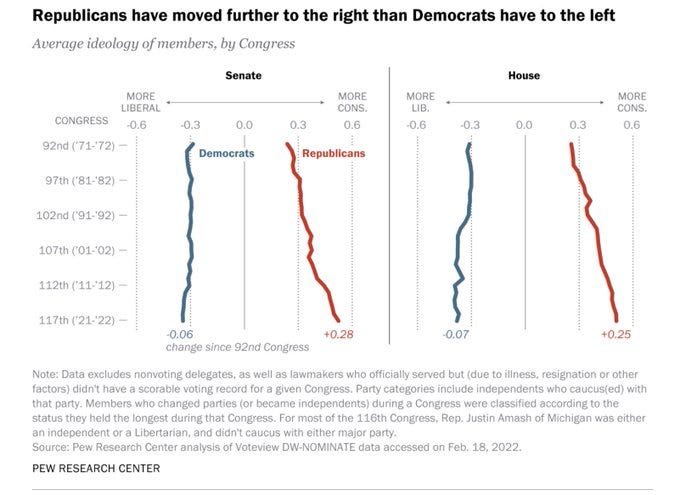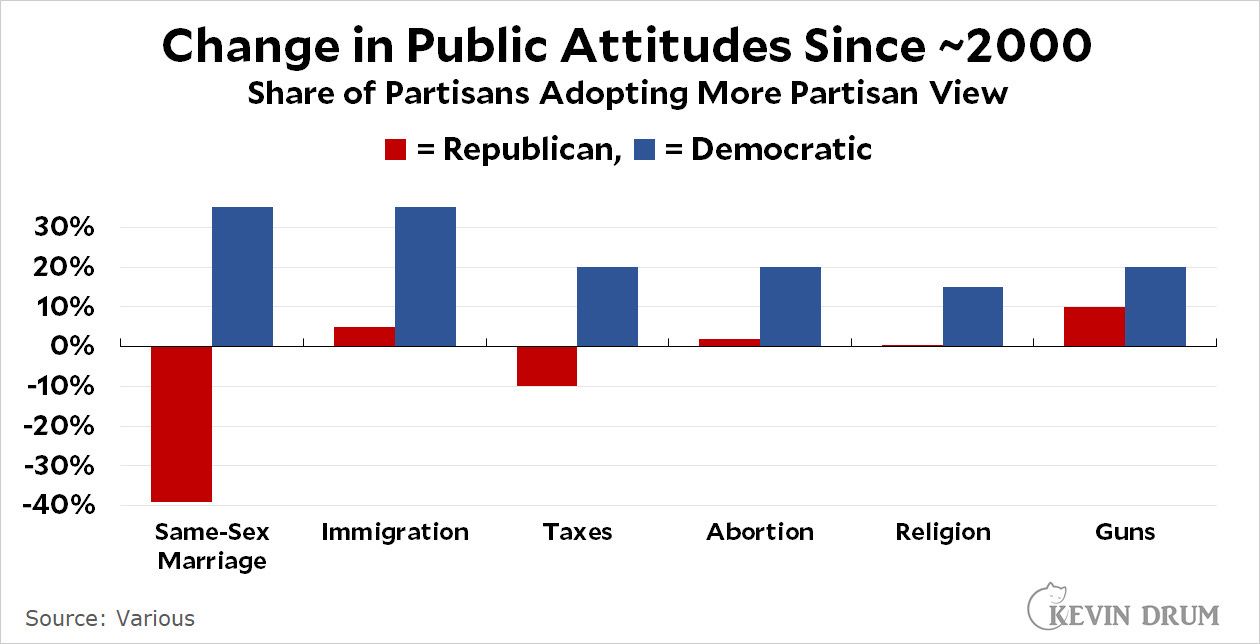Have America's liberals moved left faster than conservatives have moved right?
On the latest Elon Musk-inspired Twitter debate
Elon Musk, the world’s richest man and soon-to-be owner of Twitter, has spent the better part of his time since purchasing the platform earlier in the week wading into various cultural and political debates. Yesterday, he shared a meme that caught the eyes of several users in the political science world:
This opened up a can of worms (likely Musk’s intent) and generated considerable pushback and discussion, much of which was surprisingly productive and stimulating. Aside from the fact that the meme distills a genuinely complicated question into an oversimplified format, there seemed to be two main criticisms, one I agree with and the other I do not. The first, explicitly stated by many users, is that the cartoon wrongly assumes that Republicans have not grown more radical since 2008; I agree with this point, though with some caveats that I will explain shortly. The second criticism, which was more implicit in some of the critiques I saw, is that the chart overstates how much Democrats have moved to the left; here, I am less sympathetic.
Many of the political scientists and pundits pushing back against Musk raised the first critique, arguing there is no way to say with a straight face that Republicans have not become more radical since 2008, especially in light of their behavior during the Trump era. Many pointed to this chart:
The chart demonstrates how Republicans and Democrats have shifted in Congress, specifically. To be sure, according to the Pew Research Center’s analysis of DW-NOMINATE data1, which analyzes congressional members’ voting records and patterns, Republicans in both the House and Senate have become more conservative to a much greater degree than Democrats have become more liberal over the past 30 years. However, the chart—and this criticism—is not particularly helpful in trying to understand Musk’s (and others’) claim that the culture more broadly has shifted to the left (and their belief that this shift has left some of them, who may have once considered themselves liberals, behind). A more helpful question might be the extent to which liberals and conservatives among the public have moved ideologically toward their side’s extreme end. I’ll come back to this in a moment.
There’s a second critique pushed by many liberals: that Democrats have not moved as far left as Musk thinks. However, there is plenty of evidence showing this is indeed the case. I previously documented some of these shifts in an analysis of Gallup polling data gauging Americans’ self-reported ideology. Whereas liberals constituted the smallest slice (25%) of the Democratic coalition in 1994, they are exactly half (50%) of it today. To be sure, Republicans grew more conservative during that period as well, but their movement to the right was much slower than Democrats’ drift to the left.
The same patterns are visible when looking at just the past decade: the share of Democrats identifying as liberal grew from 39% to 50% (an 11-point swing), while the share of Republicans identifying as conservative increased from 71% to 74% (just a three-point swing). Here is a good visualization of how these changes happened:

It is true, looking at the above chart, that far more Republicans identify as conservative than Democrats do as liberal. However, America has always been slightly more conservative than liberal overall. For example, take the Democratic side of that chart: in 1994, the same shares of Democrats identified as conservative (25%) and liberal (25%). The more interesting trendline in this data, however, is the fact that the share of liberal Democrats doubled over the past 25 years.2
We can also see these trends in each side’s attitudes on various cultural issues. Liberal political observer Kevin Drum wrote a piece last year provocatively titled, “If you hate the culture wars, blame liberals.” If you can get past the headline, Drum does a great job of detailing how Democrats and Republicans have changed their views on hot-button issues since 2000. Here is what he found:
What this shows is that while Republicans have become slightly more conservative on a few issues and actually moderated (or moved to the left) on things like same-sex marriage and taxes, Democrats have grown more liberal on all of them—and to a far greater degree than Republicans have moved rightward on any of them. Drum, a liberal himself, isn’t necessarily upset about this change, but he does recognize that it may be contributing to conservatives’ reactions. He also referenced an analysis conducted by The Economist, which showed a trend that looks somewhat similar to the one Musk portrays in his meme:
The key difference between this visual and Musk’s cartoon is that the median Republican in the chart above objectively moved to the right between 2004 and 2017. However, Democrats did in fact move heavily to the left during that period, so much so that they are now further away from the median American than Republicans are. Drum explains:
As you can see, in 1994 the average Democrat was at 5 and the average Republican was at 6. In 2004, that had changed slightly: the average Democrat was at 4 and the average Republican was just under 5. In other words, both parties had gotten a little bit more liberal.
But by 2017 that had changed completely. The average Democrat was at 2 while the average Republican was at 6.5. In other words, between 1994 and 2017, Democrats had gotten three points more liberal while Republicans had gotten about half a point more conservative.
That takes us up to 2017, by which time Democrats were quite obviously farther from the median voter than they had been in 1994 or 2004. And it showed: Our election victory in 2020 was razor thin even though (a) the economy sucked, (b) we were in the middle of a pandemic, (c) voters had had four years to see just what Donald Trump was really like, and (d) our candidate was bland, amiable, white, male Joe Biden. This should scare the hell out of liberals.
It should also be evident to those who have followed the evolution of American culture over the past decade that many of the country’s major institutions have become much more liberal (including some that already leaned that way), such as colleges and universities, the media, Hollywood, the arts, and even corporations, which conservatives used to see as a safe haven. In response, many on the political right have concluded the only remaining forum in which they can still exert their power is government.
And this is where the left-right dichotomy presented in both Musk’s meme and the responses to it breaks down. It’s also where I return to the first criticism—that the meme understates (or doesn’t even show) that Republicans have become more radical—which I said I believe has happened. As Drum illustrated, Republican voters have actually moderated on some issues. To some degree, elected Republicans have done the same.
Think back to Trump’s campaigns for office: he adopted several positions which ran counter to the conservative orthodoxy that had been dominant in the Republican Party since Ronald Reagan, such as on gay marriage and the social safety net. Even in Congress, most Republicans have stopped supporting efforts to define marriage as between a man and a woman and repeal the Affordable Care Act while many supported a massive stimulus bill under Trump that would have been unthinkable not even 10 years ago. (Of course, elected Republicans remain very ideologically conservative on other key issues, such as abortion.)
So it’s not as helpful to ask which party has moved further to its ideological extreme because these changes don’t all have to do with ideology or policy issues. Rather, Democrats have become more liberal on a whole set of issues while Republicans have become more reactionary in response—something that Musk fails to grapple with—and begun using government to fight back. New York Times columnist Ross Douthat, responding to the Musk tweet, put it this way:


Essentially, the culture overall has become more liberal, which has led to liberals gaining more influence in powerful institutions. Meanwhile, the Republican Party has grown more extreme, but not solely (or even largely) on policy. Political observer Matt Yglesias similarly contends that while the GOP has grown “more unhinged…more conspiratorial, more unethical, more flagrantly dishonest…and more potentially damaging to the basic foundations of the Republic,” they have “clearly moved to the center on concrete policy issues.” On issues like voting rights and the response to the January 6 Capitol insurrection, Republicans on the whole have arguably grown much more extreme. But those issues are more about commitment to democracy and democratic norms than they are liberalism vs. conservatism.
When people flatten this conversation into a basic left-right binary, it can lead to bizarre behavior—for example, arguing that folks like comedian Russell Brand, former Democratic Rep. Tulsi Gabbard, philosopher Sam Harris, psychologist Steven Pinker, and Elon Musk himself are “right-wing.” This type of thing goes to the core of Musk’s (haphazardly formed) argument: that he has not changed, but the culture around him has to such a degree that people like him are now thought of as being aligned with Trump and his ilk.
The reason any of this matters is because of what each coalition’s changes have meant for our politics. Many conservatives have viewed the increasingly liberal influence in the country’s institutions (and conservatives’ perceived exclusion from them) as a threat to their way of life and responded by electing leaders who promise to combat these trends—which almost always exacerbated preexisting tensions. Liberals have subsequently moved to find ways to break the conservative stranglehold on our political institutions, like redistricting, the Electoral College, and the Supreme Court.3
As each side grows further apart and comes to increasingly see each other as a threat, they will look for more ways to dislodge the other from power. I don’t know where this ends, but I’d be lying if I said it’s a healthy way to run our American experiment.
It’s worth noting that there is an unsettled debate over how useful DW-NOMINATE scores are.
This is due to a number of factors, including the fact that younger people are more liberal today than in previous generations as well as things like the “great Awokening” of the past decade.
Meanwhile, the exhausted middle—about 37% of the country—is sitting on the sidelines with no clue where they fit into all this.








